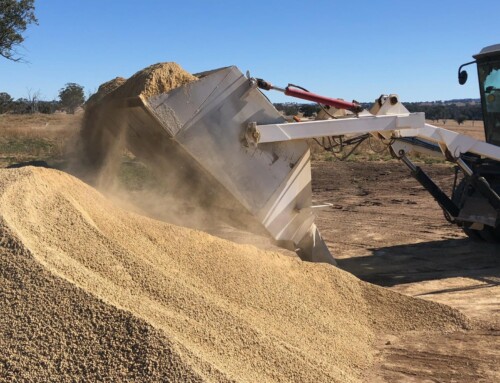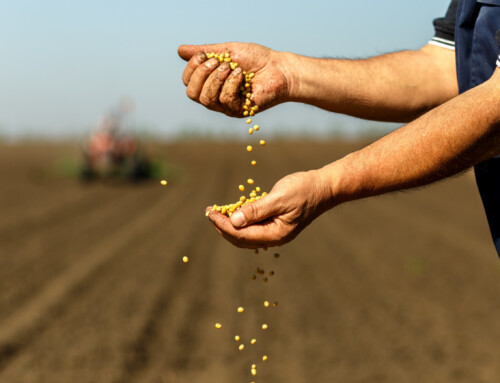Putting the dollars into sodic soil management
Key Points of the GRDC article:
– Sodicity is the presence of too much sodium (Na) in the soil.
– Australia represents the majority of the world’s sodicity issues which can lead to a reduction in plant growth and grain yield as well as decreased soil structural ability.
– Soil amelioration of sodic soil with gypsum has increased crop yields of wheat, chickpeas, sorghum and canola.
– Opportunities exist for further research into the practical application of amelioration strategies such as gypsum and their potential cost/benefit to growers across a range of soils and environmental situations.
– Like most cropping issues, growers and agronomists need to complement their knowledge of the underlying bio-physical systems with careful observation to craft a solution that is appropriate for individual situations.
Future research into sodic soils in Australia’s northern cropping belt should aim to equip growers with the decision-making tools to implement feasible and cost effective management strategies. Dr Neal Menzies from the University of Queensland’s School of Agriculture and Food Sciences believes that while the adverse effects of sodicity on plant growth are well documented, important knowledge gaps still remain in scientists’ understanding of sodic soils.
Addressing advisors and growers at the recent Grains Research and Development Corporation (GRDC) Grain Research Updates, Dr Menzies said these gaps centred on the practical application of amelioration strategies and the potential cost/benefit to growers across a range of soils and environmental situations. “We need to be better able to predict on which soils an economic benefit will be gained from the application of gypsum, including setting the appropriate rate of application, and frequency of repeat applications,” Dr Menzies said.
“We also need to develop strategies for the amelioration of sodic subsoils and improve our ability to predict when subsoil amelioration will be economically attractive. It is also important that we refine water and nutrient management approaches for sodic soils and better understand, and hence be able to optimize, alternative amelioration strategies such as organic matter management.”
Simply defined, sodicity is the presence of too much sodium (Na) in the soil. Australia represents the majority of the world’s sodicity issues which can lead to a reduction in plant growth and grain yield as well as decreased soil structural ability which underpins a range of physical problems within the soil.
Management usually relies on gypsum applications but devising a comprehensive and targeted management strategy can be difficult due to the vast differences between soils, such as in clay content, organic matter content and mineralogy, and the broad range of effects Na has on soils and plant growth.
At a mechanistic level, the adverse effects of sodicity on plant growth are well understood by the research and extension communities.
Unfortunately though, differences in soil and plant characteristics, climate and agronomy mean that this understanding cannot be directly converted to a simple set of fool-proof rules, according to Dr Menzies.
“Like most cropping problems, growers and agronomists need to complement their knowledge of the underlying bio-physical system with careful observation to craft a solution appropriate for their situation,” he said.
“The most commonly considered sodicity problem is decreased soil structural stability, and the resultant soil physical problems but we understand this problem, and have a number of amelioration strategies with which to address it.
“We less frequently consider how we should address the problem of sodicity resulting in excessively high pH (alkalinity) and although this problem is also well understood and amelioration strategies are available, in the Australian dry-land farming context their implementation is rarely economically attractive.”
Sodic soils have extremely poor physical characteristics which, in farming soils, generally lead to problems managing water and air regimes in the soil. The lack of soil structural stability results in dispersion of the surface during rainfall to form a seal. This seal limits infiltration and causes a greater proportion of rainfall to runoff, therefore reducing water availability for crops growing in the soil and increasing the risk of erosion. On drying, the seal hardens as a crust which can prevent emergence of germinating seeds resulting in poor crop establishment. In addition, sodic soils are difficult to cultivate and have poor load-bearing characteristics due to the influence of Na on the clay fraction in the soil.
“It is always important to remember that sodicity is a problem that impacts on the clay fraction of the soil,” Dr Menzies said. “In a sand with little clay fraction, sodicity will not result in adverse physical conditions although there may still be adverse chemical effects.”
At a mechanistic level, two processes – swelling and dispersion – are responsible for the behaviour of sodic soils with these two processes governed by the soil surface charge and how it is balanced by exchangeable cations.
“Clay surfaces in most surface soils carry a net negative charge. This charge results in the cations being attracted to the surface, and these attracted cations balance the negative charge on the soil – a process known as cation exchange capacity (CEC).”
The CEC has an impact on the physical and chemical properties of the soil both at the surface as well as deeper into the soil profile through the repulsion forces between soil particles. In certain situations, Dr Menzies said a gypsum application could be particularly effective as a means of improving soil surface conditions at sowing, providing better soil tilth and reducing crusting. However he stressed that timing was critically important to ensure that rainfall and/or irrigation did not dissolve and leach all of the gypsum prior to sowing. “Generally gypsum is applied at much lower rates than are required to displace all of the Na. The expectation from these smaller additions is that they will help to ameliorate the surface soil, increasing infiltration, and encouraging more uniform crop establishment.
“Repeat applications may be needed to sustain the surface soil improvement, and would certainly be needed if an impact on the subsoil sodicity was sought. “Such small applications can be economically attractive. In the GRDC funded Combating Subsoil Constraints project (SIP08) one-time surface applied gypsum at 2.5 tonnes/hectare increased cumulative gross margins by $207/ha over four crops (wheat 2005, chickpea 2007, wheat 2008 and sorghum 2009-10), reduced 115 tonnes sodium chloride from the rooting depth and increased plant available water capacity by 15mm. “Unfortunately, gypsum application is not always profitable and more effective prediction of gypsum response is needed.” As the extent of Na saturation of the CEC increases, the reservoir of cationic plant nutrients like calcium (Ca), magnesium (Mg) and potassium (K) is diminished, and the ratio of Na to the other cations in soil solution increases dramatically.
The most important of the cation nutrition problems induced by sodicity is Ca deficiency, where high solution concentrations of Na interfere with plant uptake of Ca. According to Dr Menzies, it has long been recognised that Na is not the only cation which has this effect – high concentrations of any cation can induce Ca deficiency, with aluminium (Al) especially detrimental. For this reason the ratio of Ca to the total cations in solution is a better predictor of Ca deficiency than Ca concentration alone. An even more accurate prediction of Ca deficiency is obtained when it’s expressed as a ratio of activity in solution – the calcium activity ratio (CAR), but this is a more difficult technique and really only appropriate as a research tool.
Ca has an important role in stabilizing the pectins in plant cell walls and as Ca cannot be readily translocated within the plant, there must be sufficient Ca available in the soil solution within that soil volume for roots to grow into soil. Therefore Ca deficiency usually results in a poor root system which indirectly impacts the plant through the inability of the restricted root system to acquire water and nutrients. A crop growing in a soil where sodicity induced Ca deficiency at depth has limited root proliferation into the subsoil. This causes it to be more susceptible to drought and less able to obtain nutrients at depth, rather than showing symptoms of Ca deficiency on the shoots.
On a paddock level, Dr Menzies said it was often difficult to attribute plant growth problems to a particular cause given that the physical and chemical effects of sodicity normally occurred simultaneously in sodic soils.
“For example poor soil structure will result in susceptibility to waterlogging, with the roots irreparably damaged by low oxygen availability,” he said. “But these damaged roots would not be readily distinguished from roots damaged by Ca deficiency or by alkalinity. “At a whole plant level each of these problems, or the combination of all of these problems, will result in drought susceptibility, poor capacity to capture nutrients like phosphorus which are obtained by active uptake and diffusion toward the root.”
In most instances, Dr Menzies said the same amelioration strategy applied and the application of soluble Ca (most commonly as gypsum) would address the majority of production issues. Nevertheless he said some knowledge of the specific problem faced could be extremely valuable for the development and implementation of a remediation strategy. “For example, the various aspects of poor soil structure caused by dispersion are a diffuse double layer problem – the zone of increased cation concentration and decreased anion concentration. But, individual expressions of poor soil structure require different remediation strategies,” Dr Menzies said.
“At the immediate surface of the soil, dispersion can result in surface sealing, and in the short term this can be addressed by increasing the ionic strength of the soil solution through the application of relatively low rates of gypsum. “These applications must be repeated regularly as rainfall will dissolve the gypsum and leach it down through the soil profile. Once the solid phase gypsum is all dissolved, the ionic strength of the soil solution will fall – approaching the very low ionic strength of rainwater at the soil surface – and the risk of surface sealing will re-emerge.
“Deeper in the soil profile, the ionic strength of the soil solution is much more buffered, and the beneficial effect of gypsum application is limited to the replacement of Na by Ca on the CEC.”
Caption: Dr Neal Menzies from the University of Queensland’s School of Agriculture and Food Sciences believes that while the adverse effects of sodicity on plant growth are well documented, important knowledge gaps still remain in scientists’ understanding of sodic soils.
Author: Sarah Jeffrey, Senior Consultant Cox Inall Communications – Dr Neal Menzies University of Queensland, School of Agriculture and Food Sciences – See more at: http://www.grdc.com.au/Media-Centre/Media-News/North/2015/04/Putting-the-dollars-into-sodic-soil-management#sthash.DbSCgqem.dpuf











